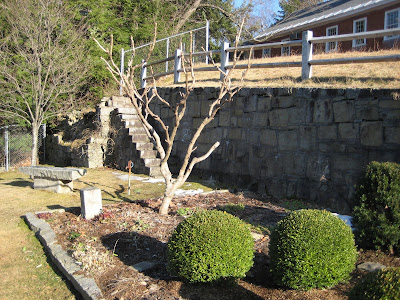


and Salix purpurea ' Nana', right

 Miscanthus floridulus 'Giganteus
Miscanthus floridulus 'Giganteus
The Boccelli Garden, a mixed border, was cleared and prepared for the growing season. All the spent stems of the perennials were cut back. The leaves of the hellebores were removed to make way for the emerging flowers. The large grasses, Miscanthus floridulus 'Giganteus' and Miscanthus sinensis 'Silver Shadow' were cut to the ground. The rigid 8 foot long stems of Miscanthus floridulus 'Giganteus' are stored because they make excellent supports when staking plants during the growing season.
Three trees or large shrubs, Catalpa bignonioides 'Aurea', Gleditsia 'Ruby Lace' and Cotinus coggygria 'Royal Purple', are stooled, each to about 18 inches, to encourage robust new foliage. The catalpa leaves are huge chartreuse paddles that contrast well with the small leaflets of the purplish bronze compound leaves of the honeylocust tree. The rich maroon-red foliage of the smoke bush looks stunning against any foliage or flower color imaginable. In general, red, chartreuse and grey foliage are effective mixers with both hot and cool color schemes.
The seven foot tall Viburnum sargentii 'Onondaga' was limbed up so its branches do not overpower the underlying perennials. It was chosen for this border for its velvety maroon young foliage, creamy white flowers and red fall fruit. The old black stems of Rosa rubrifolia were thinned out to encourage new growth from the ground. The foliage has a beautiful grey color with a copper cast to it; the pink flowers are an added bonus.
The Ribes alpinum 'Aureum' was shaped slightly. Dan Hinkley, the famous plant hunter and founder of Heronswood Nursery, described this currant in the 2000 catalogue: "I have brought this back from England on three occasions, each time from suckering stems offered by Christopher Lloyd while walking his remarkable, cherished Dixter, and each time, but the last, losing the plant. Finally, we have this established in our garden, and finally we are able to offer but a few, with small brilliant yellow foliage (fading to lime as the season progresses), on stems forming compact mounded shrubs 4 ft. by 4 ft., in full sun and well-drained soil. For no extra fee, the magic of Dixter is eternally bound to each and every plant." Well, that sold me!!!
Finally, several dead or damaged branches of the Aralia elata 'Aureovariegata' were removed. This connoisseur's small tree has a bold winter skeleton and large compound leaves with golden edges. This particular specimen is the largest and happiest I have ever seen in a garden. To be quite honest, I am not sure why. I have killed the same plant in my own garden.
Now the garden is ready for the season to begin. You can see the Boccelli Garden in its full glory in the slideshow on the sidebar. Christopher Lloyd's book, Succession Planting for Year-round Pleasure, is an excellent resource on how to build your own mixed border.




Michael:
ReplyDeleteMany of the selections in this garden made my heart soar: well, soar only because if I haven't the space, I am glad they are being used where people can witness some truly spectacular architectural specimen trees and shrubs.
I vividly remember the first time I stumbled upon V.s 'Onondaga' - 'twas Springtime and the velvety maroon foliage was nothing short than stunning! Sadly, the genus is riddled with pests here in Ontario, and I looked elsewhere. (C.a 'Golden Shadows) I am still enthralled with it and may reconsider!
Catalpa - how can one not lose their heart to this beauty. The sheer size of the foliage, and when in flower..... you know what I mean! H.p 'Pink Diamond' far and away is my favourite of the species - so delicate in bloom!
This is a wonderful post that truly shows your love of architectural plant material. Thanks for sharing!
Teza,
ReplyDeleteThanks for your comment. I keep hearing about problems with viburnums. I have been lucky so far. If disaster strikes, I hope I will look at it as an opportunity (after a proper period of mounring)to try something else.